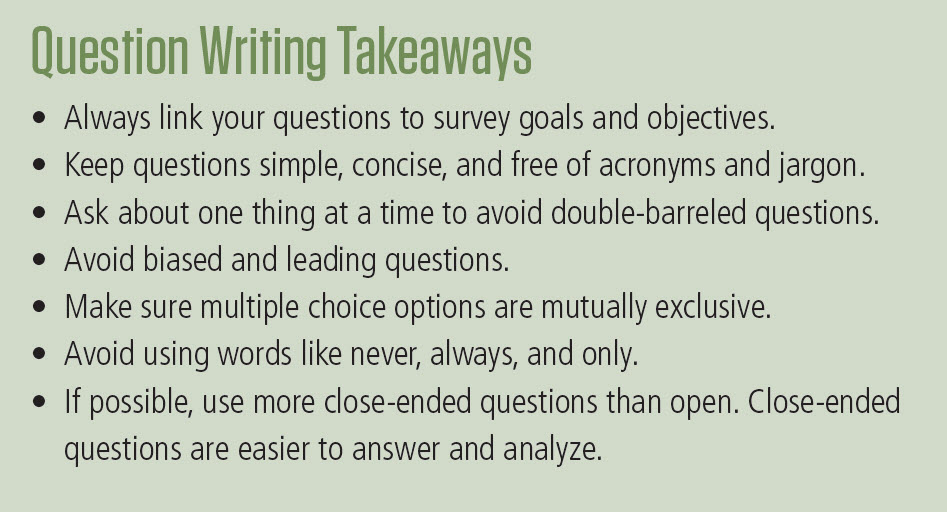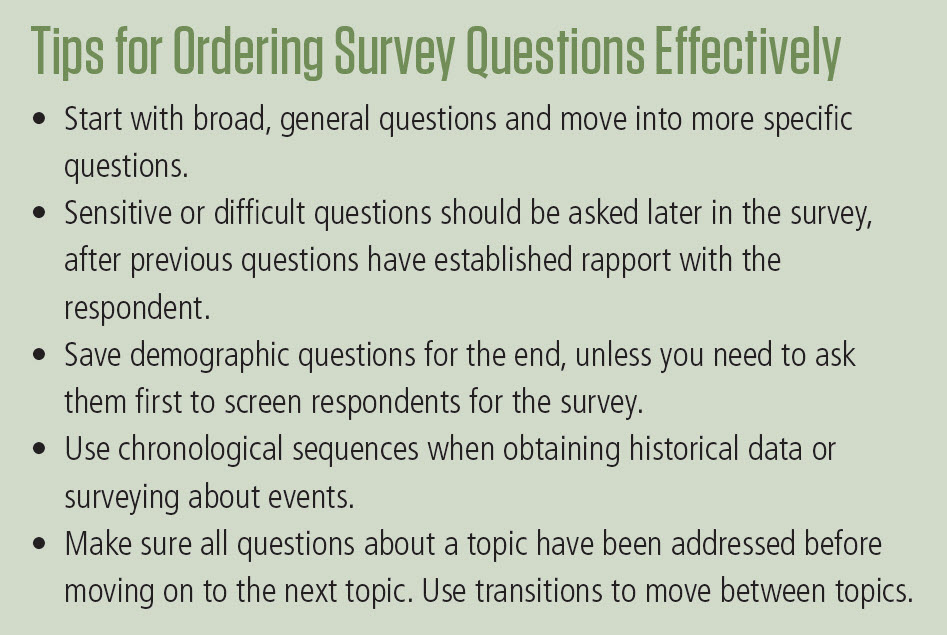
14 Jun REDCap Surveys 101: A Guide to Writing and Designing Effective Surveys
It seems simple. Write some questions. Paste them into REDCap. Hit send. And within minutes, your REDCap dashboard is full of useful, interesting data.
But anyone who has written a survey knows it is not that easy. Even the slightest variation in survey design or question format can seriously impact your results. Ask the wrong questions, or ask them in the wrong way, and you will end up with data that is unreliable or unneeded.
That is why it is so important to take the time to develop survey questions. Good questions are the key to good data. This guide will help you write and design REDCap surveys that engage respondents and help you get the data you need.
First, start with a goal.
Before you even begin writing and designing your survey, you need to identify your goals for the survey. What do you want to know? Who are you surveying? How will the results be used initially? This information will guide the direction of your survey.
For example, a survey goal may be:
“To assess the satisfaction of those who attended the 2016 Clinical Researchers Conference.”
Choose your words carefully.
Now that you have identified the survey’s goals and objectives, you can begin writing the survey questions. As you write, examine how well each question addresses the goals and objectives you have outlined. The following questions will help you create goal-oriented survey questions.
Is the question necessary and/or useful?
Examine each question to see if you need to ask it at all. Don’t ask the question if the response cannot be tied back to your goal. Extra, unrelated questions can lead to respondents wondering, “Why are they asking this?”
Remember that you are also asking respondents for their most important commodity: time. Asking unnecessary questions can lead to a lengthy survey, which can result in lower response and completion rates.
Does the respondent need more information?
Look at each question to see if the respondent has the right information to answer the question. For example, let’s say we ask the question, “Please rate your level of satisfaction with chart abstraction services provided by the research coordinator.”
If the respondent did not receive chart abstraction services, he or she will not be able to answer this question. In this instance, we should add a seed question (e.g. “Did you receive chart abstraction services from the research coordinator?”), before asking for opinions about the session.
Does the question need to be more specific?
Sometimes questions can be too general, which makes data difficult to interpret. For example, let’s say we want to find out respondents’ opinions about the conference’s morning group session. We could ask them:
“Please rate your level of satisfaction with the morning group session using a scale of ‘Extremely satisfied’ to ‘Extremely dissatisfied’.”
But would that mean? What if they were satisfied with certain aspects of the session but found other aspects lacking? Instead, you might break it down into more specific sections:
“Please rate your level of agreement with each statement below about the morning session.”
| Strongly Agree | Agree | Neutral | Disagree | Strongly Disagree | |
|---|---|---|---|---|---|
| The speaker clearly and effectively presented the materials. | |||||
| The content was relevant to my professional needs. | |||||
| I learned skills or knowledge that I can apply in my work. | |||||
| The learning objectives were well-covered. | |||||
| My knowledge/perspective on the topic was broadened. | |||||
| Overall, this session was worth my time. | |||||
| Please provide comments about any of the areas above, especially if you indicated you Disagreed or Strongly Disagreed with any of the statements: |
Draft your questions.
With these questions in mind, you are now ready to begin writing. As you write your survey, remember that your choice of words and phrases directly impacts the way respondents react to and interpret your questions. Even the smallest differences can change the way respondents answer.
Keep these points in mind while drafting survey questions.
Write questions that are simple, direct, and familiar.
In general, questions that are concise, clear, and use simple language are more easily understood by respondents.
For example:
Not so good: Do you use any medicines several times per week or per month?
Better: Do you regularly use medicines?
Avoid using abstract terms, acronyms, and jargon.
Write out acronyms or abbreviations the first time. Provide further description if needed. Use examples to help explain terms and concepts to survey respondents.
Not so good: The conference activities facilitated active learning.
Better: The conference activities (e.g., break-out sessions, networking opportunities, keynote speaker) helped keep me engaged during the conference.
Make sure that responses are in a logical order and match the question.
If you are using a rating scale, each response should be clearly higher or lower than the other for all people. Questions and responses should also be logical matches. For example, if you are asking about satisfaction, the logical scale would be “highly satisfied” to “highly dissatisfied.”
Avoid these common question-writing mistakes.
Double-barreled questions
To eliminate confusion, avoid asking respondents to evaluate more than one thing, such as “Do you feel better after the procedure and taking the medication?” The procedure and the medication are two separate things, requiring two different questions. You can search for double-barreled questions in your survey by looking for “and” or “or” in your questions.
Biased questions
Make sure the wording in your questions does not lead respondents to a particular conclusion. For example, the question “Do you think that the 2016 conference offered a better variety of breakout sessions topics than last year?” drives respondents to the conclusion that the 2016 conference offered more. Instead, create a more neutral question and answers:
How do you feel about the 2016 conference breakout session options compared to last year’s options?
( ) The 2016 conference offered a better variety
( ) The 2015 conference offered a better variety
( ) The selections are similar
( ) No opinion
Loaded and leading questions
Avoid using loaded, emotional terms in questions. For example, consider the question: “Exercising on a regular basis can be challenging. Did the intervention help you stick to a regular workout routine?” To avoid bias and leading, write more neutral questions, such as:
The intervention helped me exercise on a regular basis.
( ) Strongly agree
( ) Agree
( ) Disagree
( ) Strongly disagree
( ) No opinion
Overlapping responses
Make sure multiple choice options are mutually exclusive. Response options are not mutually exclusive if a potential answer fits more than one of the response options. For example: “What is your current age? A.) 10 or less B.) 10 to 20 C.) 20 to 30 D.) 30 or greater.”
Determiner
Avoid asking questions that use terms such as always, never, and only. In the question, “Do you always take your medication on time?”, a respondent who missed one dose would have to answer no.
Plan the order and flow of your survey.
Once the questions are developed, attention should be paid to how they are ordered. Like a conversation, survey questions should be grouped by topic and unfold in a logical order.
For example, in our survey for conference attendees, there is a lot we want to know about: morning and afternoon sessions, keynote speakers, networking, and so forth. If you mix these topics throughout the survey, you will most likely end up confusing and frustrating your respondents. Instead, break your survey into obvious sections. At the beginning of each section, offer a quick introduction, such as, “This section asks questions about the morning breakout sessions.”
Take time to test your survey.
When you have finished creating your survey, test it thoroughly. Make sure the survey design, branch logic, and settings are working properly. Running a test before you send can prevent headaches down the road and ensure you get the data you need.
As you test it, think about the survey as if you are respondent. Are the directions clear? Are the questions concise? Were there any confusing questions or response options? How long did it take to complete the survey?
Once you have successfully completed your test survey, you are ready to distribute. Looking for tips on crafting survey invitations that get responses? Read our guide, “Four Easy Ways to Boost REDCap Survey Rates.”
Want REDCap tips like this delivered to your inbox?
Sign up for our monthly newsletter to receive REDCap guides and tips.










